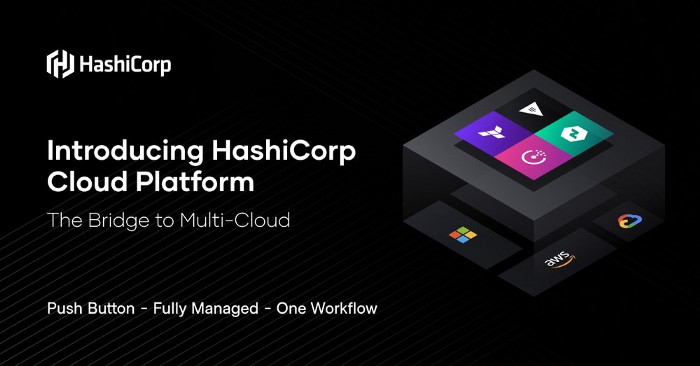Last Wednesday was the end of the HashiConf Digital 2020. In its keynote, we have been granted some news about several Hashicorp’s products as well as some already published announcements. One news have made this keynote better : launch of Hashicorp Cloud Platform. Here is my opinion on what it is, what it could be and how it could affect the cloud ecosystem.
Since the beginning, Hashicorp have put its efforts on helping people manage infrastructure related tasks such as providing consistent virtual machines for both workstations and servers with Vagrant and Packer. The cloud-ready era came to be and tools like Terraform and Serf sprang to life to answer the new challenges. Now that we are in the cloud-native era, Vault, Consul and Nomad are growing mature enough to be considered solid options. Somehow, Hashicorp still didn’t fully adopt the cloud delivery model, where teams don’t have to worry about operating middlewares, consuming them in a SaaS fashion.
Terraform cloud registers a tremendous adoption, and Hashicorp Consul Service for Azure meets a very warm welcome. What was the only next step Hashicorp could take to satisfy even more adopters ?
Hashicorp Cloud Platform (a.k.a. HCP) is a new platform launched by Hashicorp that aims to provide its core infrastructure softwares as a service. This new product is envisioned in 3 points. First, push-button deployment. Once connected to your HCP account, all you have to do to be provided with a cluster is to click on a button. Thereafter, your cluster is ready to be integrated in your software, Hashicorp manages all the operations work. Then, fully managed infrastructure. This is not an automated helm deployment nor a meta-marketplace, you don’t have to provide your VMs or Kubernetes cluster. You just consume the service you subscribed for. Last, but not least, one multi-cloud workflow. This solution provides Hashicorp’s tools on different platforms [editor’s note: AWS, Azure and GCP were illustrated in the corresponding slide] and bridge them together for you.
We have not many technical information, but some interesting points have been shown.
First, the core objects you need to create are hashicorp virtual networks (a.k.a. HVN) and peering connections. HVNs seem to be plain virtual network from a cloud provider in which will be deployed the needed clusters. peering connections are what their names are for : since the HVN is not accessible to the final user, one needs to peer its virtual network to his HVN in order to consume his services. Thereafter, HCP provides you with client configuration and a ACL token in order to consume the service.
Even though the connection peering process has not been shown, the only provider supported being AWS (in only one region, us-west-2) and Nomad yet to be announced, the SaaS-style provisioning is still convincing as there seems not to be any fancy technologies at stake here. Plus, thanks to their decentralized and federated architecture, one could deploy one cluster per region and/or per provider and not feel overly attached to that provider.
From this paragraph, you will be reading my personal understanding on the situation. I might over-interpret some facts and not represent Hashicorp’s point of view or long-term strategy.
Hashicorp announced a solution for a multi-cloud, fully managed deployment and the one product I see it challenges is Google Anthos. Both provide network connectivity and workload orchestration and even though Mitchell Hashimoto did not talk about competing with Google, the goals are alike but the means are different. Image for post Image for post Screenshot from Google’s “What is Anthos ?” video
So we now have a challenger for Google Anthos, and its name is Hashicorp Cloud Platform. Kind of, because Anthos is much more than just orchestrating networks and containers, thanks to GCP’s tool set that have already been battle-tested.
The main difference between Anthos and HCP is that HCP does not host its services itself, but you choose in which cloud/region you want hashicorp to operate those services. Like any Hashicorp products, its users will define how it will grow by using it and defining its best practices.
Because, yes, HCP is still very young as it provides only Consul in one AWS region, and soon Vault in the same place, but since Consul has already been integrated in Azure, we can assume HCP will come soon enough with microsoft’s cloud provider.
Combined with Nomad’s autoscaler, we will soon be able to provide just some projects in several cloud providers and plug them together around HCP with Terraform (using Terraform cloud, of course), initiate Vault, Consul and Nomad as a service (through an upcoming Terraform provider I bet) and let Nomad manage the workloads, enabling a true host-neutral multi-cloud experience. But, hélas, Nomad is not Kubernetes, the de-facto standard container orchestrator. Even though Nomad could start accepting Kubernetes manifests as inputs, and become a flavored Kubernetes product like OpenShift, Kubernetes cluster creation automation is so widespread today it will be difficult to tackle without some killer features.

Comments
No comments yet. Be the first to react!